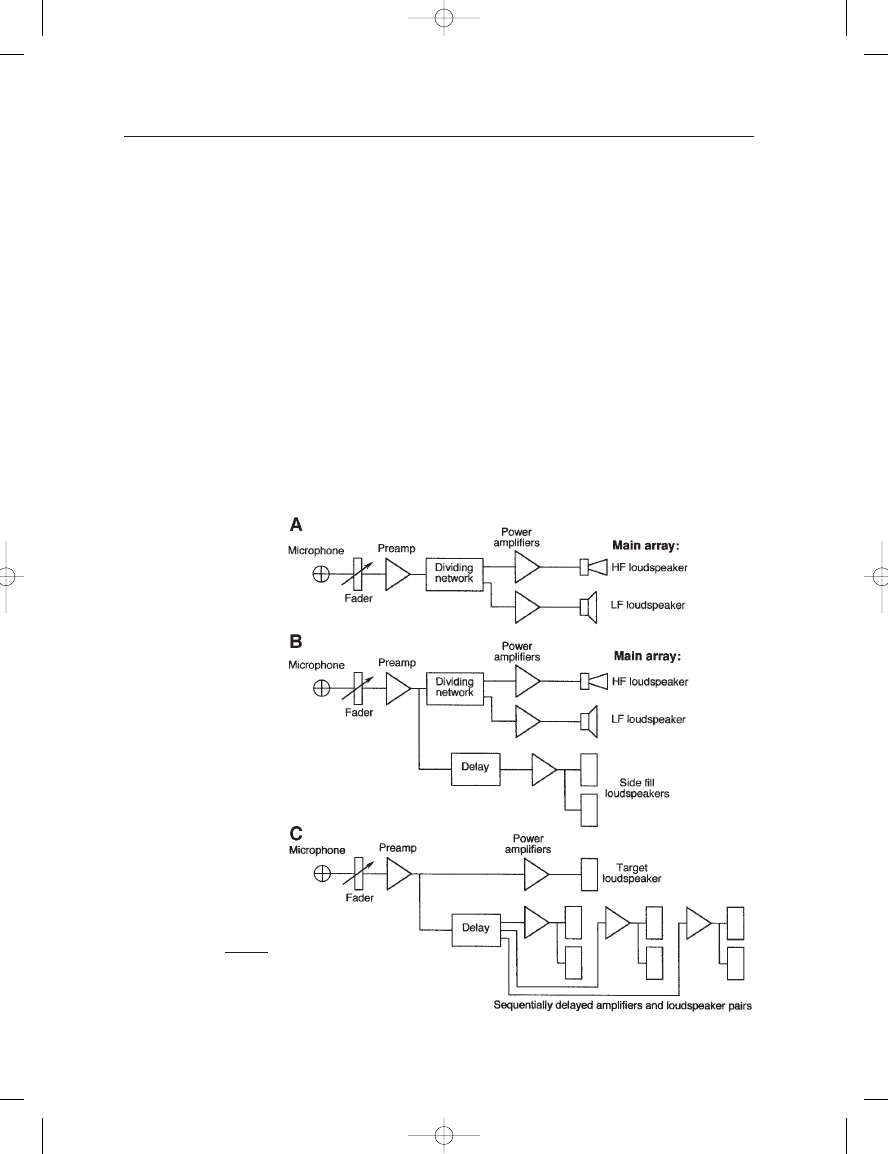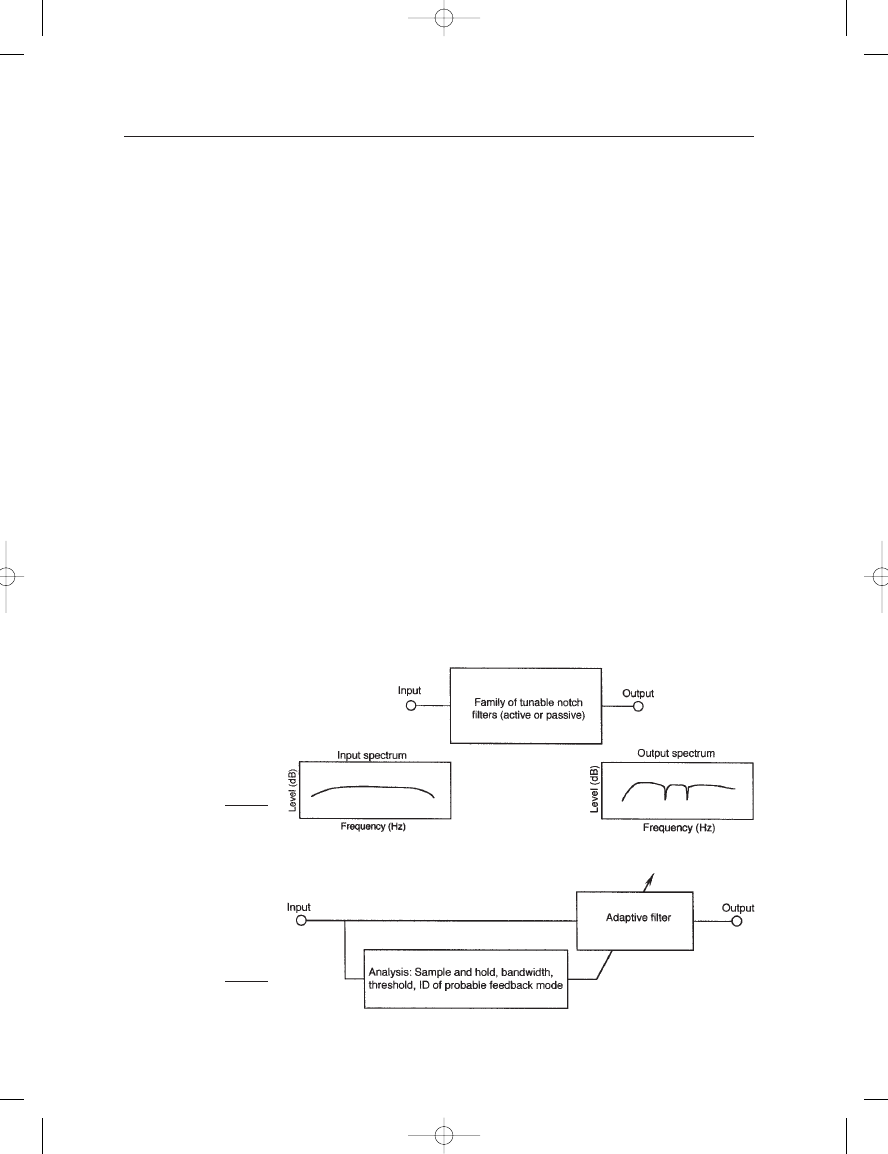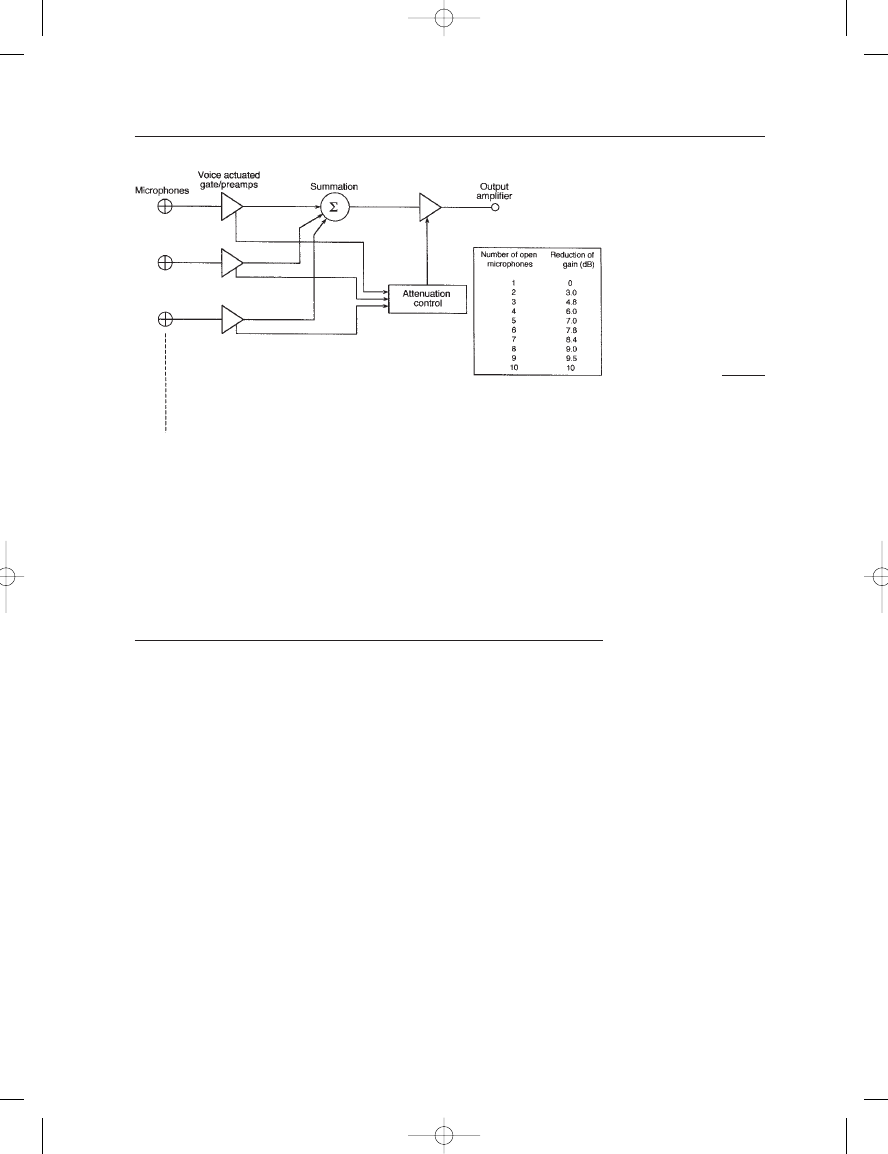ВУЗ: Казахская Национальная Академия Искусств им. Т. Жургенова
Категория: Книга
Дисциплина: Не указана
Добавлен: 03.02.2019
Просмотров: 17255
Скачиваний: 51

on the side walls, sequentially delayed in order to produce a natural
effect. In this approach, shown at C, each listener is relatively close to a
loudspeaker and will thus benefit from the increase in D/R ratio. In many
venues, these side mounted loudspeakers will be simple vertical column
models, which have broad horizontal response (to cover the audience
effectively) and narrow vertical response (to avoid excess signal “spill”
onto the walls). Some installations include an undelayed target loud-
speaker located at the front of the room which helps to define the actual
sound source at that natural position.
As you can see, the design choices must be carefully made, and at
each step in the design process a new analysis of the system’s intelligibil-
ity estimate must be made. Very large venues such as sports arenas and
stadiums are obviously more difficult to design and analyze.
Signal flow diagrams for the three systems of Figure 18–10 are
shown in Figure 18–11. As the number of delay channels increases, the
target coverage areas of loudspeakers in each delay zone are restricted to
a specific portion of the seating area. The aim here is to provide coverage
18: Fundamentals of Speech and Music Reinforcement
313
FIGURE 18–11
Signal flow diagrams for
the systems shown in
Figure 18–10.
Earg_18.qxd 14/9/04 3:01 PM Page 313

where it is needed for maximizing the D/R ratio. Ideally, the “spill”
outside each area should be minimal, but in practice it is difficult to
control.
ELECTRONIC CONTROL OF FEEDBACK
The usual cause of acoustical feedback, even in properly designed
systems, is the careless raising of microphone input levels to “reach” for
a weak talker. Another reason could be that too many microphones are
open at the same time. When a skilled operator is at the controls, things
rarely go wrong. But many systems are operated by amateurs or volun-
teers who do not understand the basic nature of feedback. In order to
make systems failsafe in the hands of such operators, manufacturers have
come up with a number of electronic devices that inhibit feedback to a
greater or lesser degree. We discuss some of them below.
THE FREQUENCY SHIFTER
The frequency shifter was developed during the 1960s as a means of
minimizing feedback by shifting the amplified sound up or down in
frequency by about 4–6 Hz. As such, the effect was not easily noticed on
speech. Music was however another matter; even slight frequency shifts
are audible as a slow beating effect, especially in sustained passages.
When the frequency is shifted, it is difficult for the conditions necessary
for feedback to become established; however, excessive gain will result in
a time-varying “chirping” effect as the system tries unsuccessfully to
reach steady feedback. A signal flow diagram of an early frequency
shifter is shown in Figure 18–12. Today, the technique is more sophisti-
cated, consisting of a slow, random frequency shifting action rather than
a fixed relationship.
NARROWBAND EQUALIZATION
In the hands of properly trained acousticians the insertion of narrow-
band notch filters into the audio chain can minimize feedback, resulting
in improvements of up to 4 to 6 dB in overall gain capability (Boner and
Boner, 1966). The technique involves driving the system slowly into feed-
back, determining the frequency of feedback, and inserting a narrow-
band filter at the feedback frequency. This procedure is done sequentially
for the first three or four feedback modes of the system; beyond that
THE MICROPHONE BOOK
314
FIGURE 18–12
Details of a frequency
shifter.
Earg_18.qxd 14/9/04 3:01 PM Page 314

point there will be diminishing returns. The method is now normally car-
ried out using parametric equalizer sections, as shown in Figure 18–13.
FEEDBACK ELIMINATORS
Based on digital signal processing, sophisticated methods of signal analy-
sis and treatment can produce systems that can detect the presence of
sustained feedback, determine the feedback frequency, and automatically
engage the necessary filtering to control the feedback. A simplified signal
flow diagram is shown in Figure 18–14.
AUTOMATIC MICROPHONE MIXING
Automatic mixers are widely used in many systems employing a number
of microphones. For example, a house of worship may have micro-
phones present on the lectern, pulpit, baptistry, and altar. It is clear that
only one of these microphones will be in use at a given time. Gating the
microphones on and off does not necessarily require an operator; using
a properly adjusted automatic microphone mixer, the control of the
microphones can be smooth and foolproof. Figure 18–15 shows a basic
signal flow diagram for an automatic mixer.
In many applications it will be necessary for more than one
microphone to be open simultaneously, and under this condition there is
a function in the mixer that will attenuate system gain according to the
equation:
Gain reduction
10 log NOM
(18.5)
18: Fundamentals of Speech and Music Reinforcement
315
FIGURE 18–13
Narrow-band equalization.
FIGURE 18–14
A feedback eliminator.
Earg_18.qxd 14/9/04 3:01 PM Page 315

where NOM is the number of open microphones. The desired gain
reduction amounts to
3 dB for each doubling of open microphones and
will result in a uniform reinforced level in the space.
A well-designed automatic mixer will also provide some immunity
against false triggering of gating functions due to variations in the ambi-
ent noise level of the space.
ESTIMATING THE INTELLIGIBILITY OF A SPEECH
REINFORCEMENT SYSTEM
Where a speech reinforcement system has been installed in a venue, the
effective intelligibility of that system can be determined directly by syl-
labic testing using standardized techniques. Essentially, a talker stands at
the microphone and reads a set of random syllables, all embedded in a
“carrier” sentence. An example of this is: “Please write down the word
cat;” now I want you to write down the word man.” And so it goes. The
purpose of the carrier sentence is to present the test syllables within the
acoustical masking context of continuous speech. The results for various
listeners in various parts of the auditorium are then analyzed and the
accuracy of their responses expressed as a percentage. If a listener gets
a score of 85% on random syllabic testing, then that listener will likely
understand about 97% of normal speech in that space.
If a speech reinforcement system is still on the design drawing board,
its effectiveness may be broadly estimated, based on certain acoustical
parameters that the supervising acoustician can arrive at. For example,
the acoustician can estimate the normal direct speech sound levels at
a typical listener that will be produced by the targeted loudspeakers. The
acoustician can also determine, based on reverberation analysis, what
the reverberant level at the listener will be, as well as the reverberation
time itself. The acoustician can also make a reasonable estimate of the
THE MICROPHONE BOOK
316
FIGURE 18–15
Basic signal flow
diagram for an automatic
microphone mixer.
Earg_18.qxd 14/9/04 3:01 PM Page 316

noise level likely to be encountered in the space, based on the intended
degree of noise isolation and elimination.
If all of these estimates can be made for the octave frequency band
centered at 2 kHz, and if it can be safely assumed that there are no
unusual reflections in the room’s reverberant decay pattern, then an
estimate of the system’s articulation loss of consonants (%Al
cons
) can be
made using the following set of equations:
(18.5a)
(18.5b)
(18.5c)
(18.5d)
where
As an example, assume that our preliminary room and system simulations
give the following values: T
60
4 seconds, L
R
70 dB, L
D
65 dB and
L
N
25 dB. Calculating the values of A, B and C:
A
0.036
B
1.76
C
0.24
Entering these values into equation (18.5a), gives %Al
cons
14%.
Figure 18–16 indicates a subjective assessment of this system’s
anticipated performance as on the borderline between adequate and poor.
E
N
10
L
N
/
10
E
D
10
L
D
/
10
E
R
10
L
R
/
10
C
0.5 log
T
60
12
B
0.32 log
E
N
10
E
R
E
N
A
0.32 log
E
R
E
N
10
E
D
E
R
E
N
%Al
cons
100
(10
2(A
BC
ABC)
0.015)
18: Fundamentals of Speech and Music Reinforcement
317
FIGURE 18–16
Subjective descriptions of
%Al
cons
values.
Earg_18.qxd 14/9/04 3:01 PM Page 317